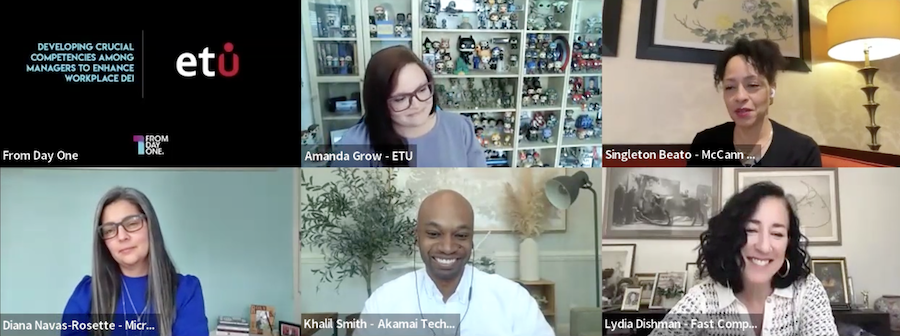Developing Crucial Competencies Among Managers to Enhance Inclusion


To improve workplaces, leaders need to reevaluate how they are growing their managers and provide the proper support. In a From Day One webinar, Lydia Dishman, senior editor of growth and engagement at Fast Company, spoke with leaders about the strategies they’re taking to address skills gaps in their companies, especially those related to boosting workplace inclusion.
Self-aware leaders display a higher level of confidence and empathy, resulting in stronger teams and effective leadership. Yet despite most leaders believing that they exhibit self-awareness, research shows only 10-15% of leaders are self-aware.
The disparity comes from the challenge of displaying vulnerability, Khalil Smith, vice president of inclusion, diversity, and engagement at Akamai Technologies, says.
“We need to be given at least an opportunity to have some of that autonomy to say, “I think that I can be better here or here,” Smith said. “It’s not a bad thing to say, ‘I do struggle with giving difficult feedback and that's not something that’s going to hold me back.’ This is different from being externally assessed because it builds the self-awareness that we need,” Smith said.
By showing empathy for others, leaders can cultivate a safe work environment for others to grow, which can be a win-win situation for companies and employees. Singleton Beato, global executive vice president and chief diversity, equity, and inclusion officer at media group, McCann Worldgroup, says empathetic leaders can reap the benefits of a stronger team.

“Being self-aware allows one to understand how to present constructive and corrective feedback in a way that isn’t demeaning to someone,” Beato said. “Doing so safely helps employees to feel that they have the support of the manager and helps them to be aware of not only whatever the correction needs to be but also to feel empowered to make that correction.”
Leaning on Newer Learning Methods
When compared to traditional learning methods, researchers found immersive learning like VR training to yield better results and also positively impact employees’ performance. Amanda Grow, director of customer success at learning company, ETU, says learning simulations can also provide opportunities for employees to learn skills that may be difficult to learn in traditional settings.
“One of the key elements in learning simulations is teaching people how to work through situations that they don't feel comfortable in,” Grow said. “Simulations have the ability to bring some of that emotion to life and make you feel uncomfortable or make you feel anxious.”
During these simulations, employees dealing with challenging emotions have an opportunity to self-reflect on their emotions in a safe space, Grow says. “We want to teach people how to reflect and understand their internal processes,” Grow said. “That's going to be valuable if we want employees to improve their self-awareness.”
Research found employees who have personal development opportunities are more engaged and have higher retention rates, showing how learning can play a large role in how employees perceive their work and growth.
Whether it’s through traditional learning modules or providing a safe environment for employees to learn, leaders play an instrumental role in bridging the gaps. Diana Navas-Rosette, general manager of global diversity and inclusion solutions, communities, and activation at Microsoft, says that Microsoft is leaning on newer technology to offer personalized learning opportunities.
“Simulations stand out as probably one of the most innovative solutions that we have in our portfolio right now. They are immersive and allow learners to practice the skills realistically and safely,” Navas-Rosette said. “A learner navigates through a simulation and then gets a report at the end that tells them what they did well and where they have areas of opportunities for them to grow. Employees can always come back and practice if they want to, allowing it to be a continuous relationship with a solution for them to build that skill set.”
Wanly Chen is a writer and poet based in New York City.
The From Day One Newsletter is a monthly roundup of articles, features, and editorials on innovative ways for companies to forge stronger relationships with their employees, customers, and communities.